January 7, 2011
Air Date: January 7, 2011
FULL SHOW
SEGMENTS
The U.S. Government Starts Regulating Global Warming Gases
View the page for this story
The Environmental Protection Agency’s new rules to regulate carbon dioxide as a pollutant just went into effect for vehicles. Vermont Law School Professor Pat Parenteau tells host Steve Curwood that the regulations will mean a large reduction of greenhouse gas emissions, but the agency faces an uphill battle with implementing future rulings. (06:15)
Deepwater Horizon Investigation
View the page for this story
Following this Deepwater Horizon disaster, President Obama set up a commission to investigate what went wrong. Host Steve Curwood talks with Frances Beinecke, president of the Natural Resources Defense Council and a member of the administration’s fact-finding commission, about the panel’s findings and what can be done to improve safety. (05:40)
Environmental WikiLeaks
/ Jeff YoungView the page for this story
The classified documents made public by WikiLeaks are revealing closed door discussions on hot-button environmental issues, including whaling, climate change and genetically engineered crops. LOE’s Jeff Young looks at WikiLeaks through a green lens. (06:00)
Some States Get Going For High Speed Rail
View the page for this story
Since President Obama announced a push to build out our nation’s highspeed rail, plans have been repeatedly sidetracked by state politics and budgets. Host Steve Curwood asks Federal Railroad Administrator Joe Szabo if rail improvement projects have much future or if Americans will be left waiting at the station. (05:00)
Prince Charles's Harmony
View the page for this story
His Royal Highness Prince Charles thinks we are careening towards environmental crisis. To avert disaster, he says we need to re-think our relationship with nature. He outlines his views in the book Harmony: A New Way of Looking at the World. Host Steve Curwood speaks with the book’s co-author, Tony Juniper. (04:30)
Judy Bonds Remembered
View the page for this story
Living on Earth remembers a crusader for the Appalachian Mountains, Judy Bonds, who died January 3rd at age 58. The miner’s daughter-turned-activist fought against mountaintop removal mining and longed to return to her family land. (02:10)
Hormone Disruptors Linked To Genital Changes and Sexual Preference
/ Ashley AhearnView the page for this story
Scientists are continuing to sound the alarm about some common chemicals, including the herbicide atrazine, and link them to changes in reproductive health and development. Endocrine disrupting toxic chemicals have been found to feminize male frogs and cause homosexual behavior. Ashley Ahearn reports on how these substances may be affecting human development and behavior. (15:15)
BirdNote® - New Year Dawns
View the page for this story
Birds from around the globe create sweet music to launch a new day and year. Mary McCann has this BirdNote®. (01:50)
Show Credits and Funders
Show Transcript
HOST: Steve Curwood
GUESTS: Pat Parenteau, Frances Beinecke, Joe Szabo, Tony Juniper,
REPORTERS: Jeff Young, Ashley Ahearn
[THEME]
CURWOOD: From Public Radio International - this is Living on Earth.
[THEME]
CURWOOD: I’m Steve Curwood. To meet its pledges - and the requirements of a Supreme Court ruling - the Obama Administration has begun regulating global warming gases.
PARENTEAU: This rule that just went into affect actually accounts for the largest single reduction in greenhouse gas emissions in the United States. It's about 9 trillion tons as EPA has calculated it.
CURWOOD: But some states and members of Congress are pushing back. Also – common chemicals affect the sexual development of frogs - and may be damaging the sex organs of baby boy.
DEVORE: One of my earliest memories is of being in a hospital and dealing with some physician taking bandages off of my genitals and watching my parents respond in obvious fear about whatever it was that this guy was doing.
CURWOOD: Synthetic chemicals may affect sexual orientation as well - That and more this week on Living on Earth – stick around!
[THEME]
ANNOUNCER: Support for Living On Earth comes from the National Science Foundation and Stonyfield Farm.
The U.S. Government Starts Regulating Global Warming Gases
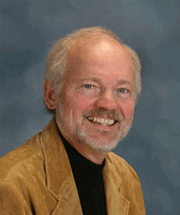
Pat Parenteau is a professor of environmental law at the Vermont Law School. (Courtesy of Vermont Law School)
CURWOOD: From the Jennifer and Ted Stanley Studios in Somerville Massachusetts, this is Living on Earth, I’m Steve Curwood. Acting in response to a US Supreme Court ruling, the Obama administration began the new year by regulating global warming gases. The White House had hoped a cap and trade bill would make regulatory action moot. But a bill passed by the Democratically controlled House couldn’t get through the Senate in 2010 and with Republicans now controlling the House, prospects for such legislation are even dimmer.
The Court ruled the Environmental Protection Agency has the authority to regulate carbon dioxide as a pollutant under the Clean Air Act, and on January 2nd it started with vehicles. Regulations for power plants and businesses will soon follow. But some states call the rules an infringement of their rights. Pat Parenteau is a professor at the Vermont Law School.
PARENTEAU: EPA has set a new fuel efficiency standard which will reduce greenhouse gasses from light trucks and cars- the standard is 35.5 miles per gallon for the 2016 timeframe. So, this rule that just went into affect actually accounts for the largest single reduction in greenhouse gas emissions in the United States.
CURWOOD: How much?
PARENTEAU: Well, it’s about nine trillion tons, actually, of CO2, as EPA has calculated it.
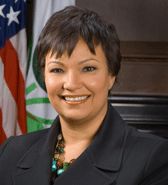
Lisa Jackson is administrator of the Environmental Protection Agency. (Courtesy of the EPA)
CURWOOD: Now, the EPA is set to launch into action regulations that would limit CO2 emissions from coal plants, electric companies, industrial emissions. How exactly would that work?
PARENTEAU: Yeah, that’s much more complicated, and obviously, more controversial. And, what EPA has done is developed what it’s called the tailoring rule, which is designed to apply their permit programs to the largest sources- those that would be in the 75,000 tons per year of CO2 emissions category. So, that would be large coal-fired power plants and oil refineries and perhaps cement plants and industries like that.
And, the way that rule would work is, if you are proposing to build a new source of that dimension, you have to get what is called a pre-construction permit, so you can’t even break ground until you’ve acquired a Clean Air Act permit. States will have to develop a program to implement these permits, and all of the states so far, except for Texas, have agreed to implement this new permit program for major new sources of CO2.
CURWOOD: What’s the beef with Texas?
PARENTEAU: Texas historically has resisted, you know, EPA running any of their air pollution, or water pollution programs. And, of course, Texas is very heavily dependant on fossil fuels. They have major oil refineries, they derive a great amount of their electricity from coal-fired power plants, so rules that are restricting of emissions from those sources are going to impact Texas industries, probably disproportionately, from many other states.
CURWOOD: Now, I understand that just Texas recently just took the EPA to court- what’s going on with that?
PARENTEAU: Yeah, this is very unusual because Texas has said, ‘we will not administer this new permit program, and, we don’t want EPA administering it.’ EPA adopted a rule right at the end of the year, on December 30th, literally, 2010, to allow EPA to issue these permits for industries in Texas that would be covered by this new tailoring rule. And, Texas is objecting to that- they don’t want these new rules to apply to Texas industries at all. And, I think it’s more about just creating controversy then it is about really expecting to win these lawsuits. If Texas prevails in this case, challenging EPA’s authority to actually issue these permits, the only thing they will have accomplished is that these sources in Texas that may need these permits won’t be able to get them. It’s hard to see how that’s a good outcome- for anybody.
CURWOOD: Now, the original Supreme Court ruling, Massachusetts vs. the EPA, mandates that the EPA regulate carbon dioxide if it is a threat to public health. It would seem to me that the agency is then legally obligated to make these regulations.
PARENTEAU: That’s exactly right. That’s EPA’s argument here, is, ‘we have a legal mandate under the Clean Air Act, to establish these rules. Now, we’ve tried to make them as flexible as possible, but we don’t have the option of not regulating them.’ So, that’s where the EPA is at this point.
CURWOOD: Now, some might say that, ‘wait a second, maybe the science doesn’t justify EPA’s endangerment finding.’
PARENTEAU: That’s certainly what Texas and others are arguing. They have a very tough row to hoe there, because the courts defer to agency expertise on these scientific questions. The courts are not going to second guess the agency on a matter like that.
CURWOOD: What would be needed to overturn EPA’s mandate to regulate greenhouse gasses?
PARENTEAU: Ah, well, that’s when we get to Congress. And, certainly the House of Representatives under new leadership has vowed to block EPA’s attempts to enforce these new rules. In the Senate it’s less clear what’s going to happen. President Obama has vowed to veto any attempt to repeal EPA’s authority, and so we’re all just going to have to wait and see how this plays out politically.

Pat Parenteau is a professor of environmental law at the Vermont Law School. (Courtesy of Vermont Law School)
CURWOOD: So, if you were running the EPA, Professor Parenteau, how difficult a scenario do you think you would be facing? I mean, how much would you be looking at in terms of budgetary cut backs and a lot of legal red tape as opponents to this regulation fight it?
PARENTEAU: Well, Chairman Upton, the new chair of the House Commerce and Energy Committee has told Lisa Jackson who is the EPA administrator that he’s reserving a parking space for her in front of the House of Representatives because he plans on having her up there, you know, virtually all the time in front of oversight hearings.
So, the EPA administrator is facing a really, really difficult political landscape. But I have to say, watching Lisa Jackson in action the last two years, I’ve been incredibly impressed with both how knowledgeable she is and how tough she can be in the face of pretty, you know, rigorous questioning from opponents of what she’s doing. She doesn’t lose her cool, but she’s not easily intimidated by that process.
CURWOOD: Pat Parenteau is an environmental law professor at the Vermont Law School. Thank you so much, sir.
PARENTEAU: You’re very welcome, Steve.
Related links:
- EPA on greenhouse gas standards
- Congressman Fred Upton (R-MI) on why the new EPA regulations should be repealed
Deepwater Horizon Investigation

The Deepwater Horizon Platform fire April 20th (Courtesy of the U.S. Coast Guard)
CURWOOD: When the Deepwater Horizon blowout spewed nearly five million barrels of oil into the Gulf of Mexico, President Obama put together a commission to investigate. The Commission has now released one key chapter of its final report - and it concludes that BP, Halliburton, and Transocean all used techniques that saved time - and money and - led to disaster.
What’s more, the commission says these problems are system-wide, making another blowout potentially right around the corner. With me is Frances Beinecke, president of the Natural Resources Defense Council and a member of the White House commission. Welcome to Living on Earth!
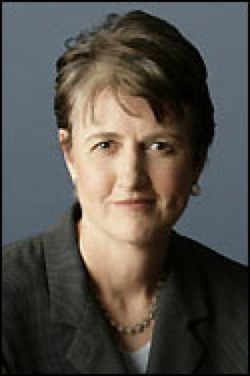
Frances Beinecke, Natural Resources Defense Council President. (NRDC)
BEINECKE: Thank you Steve, pleasure to be here.
CURWOOD: First, I have to say, that’s quite distressing that your report says that, without major changes, another incident like the blowout in the Gulf, is likely. What changes in federal regulation should be made to prevent another accident, do you think?
BEINECKE: Well Steve, I think there are two things that have to happen. Part is the responsibility of the government and the other is the responsibility of the industry. Starting with the government, clearly the Interior Department didn’t have the capacity to provide the oversight required to ensure that the offshore operations were conducted as safely as possible. And, that goes to expertise and resources. You know, the industry has gone further offshore, and more complex environments, but the Interior Department has not received additional resources to deal with that more complex situation.
On the other side, it is very incumbent on industry to develop a series of standards and develop a safety culture, which ensures that the whole industry, every company operates at the highest level. And, I think what really surprised and shocked us was that that wasn’t the case. And, they don’t have a culture in the companies, or across the industry to ensure that a safety culture is the primary operating principle. And, that’s what the commission report is really focused on- how to change that.
CURWOOD: If the federal government gets more involved in regulating this, it’s going to cost dough. What are the prospects of getting that kind of support out of Congress for changes?
BEINECKE: Well, I think, of course, that’s a very, very important issue. Now, you have to remember that the offshore oil and gas leasing program provides the second highest source of revenue to the federal government after the tax dollar. This is an enormously lucrative program to the federal government totaling billions of dollars. So, it’s imperative, really, that the Interior Department have a few hundred million, literally, to deal and provide the oversight for a multi-billion dollar industry. You know, in this instance, federal government has to make the investment to make sure that it’s done safely.
CURWOOD: And, what about the argument that tighter regulations are going to lead to higher costs at the pump? We see gas prices going up, up and up as we’re speaking.
BEINECKE: Well, gas prices certainly are going up, up and up, and this is not the reason for it. How prices are set is independent of that. But, you know, my view of this is we can’t afford not to do this. I think that the American public expects that if we’re going to drill in the offshore environment after what we all witnessed this past summer, that we should be operating at the highest international standards, in fact, we should be creating them.
CURWOOD: Frances Beinecke, what exactly went wrong in the Macondo well case? What happened?
BEINECKE: There was no single mistake, there was a whole series of judgments as that well was being drilled, and particularly as they were trying to seal off the well, after the exploratory drilling had occurred. And, the complexity of it is enormous- I mean, you have to realize that they were basically drilling it at over 18,000 feet from where the rig sat- just imagine how complex it is to know what’s happening 12,000 feet under the sea floor.
And, in many different instances with cementing, negative pressure tests, closing down the well- there were judgments made that were sort of maybe the quicker, faster way to resolve the issue, but they didn’t do a full risk analysis of what each of those decisions resulted in. So, when the well started to kick, a lot of things went wrong. And, you know the safety procedures that one would think would be in place, really weren’t.

The Deepwater Horizon Platform fire April 20th (Courtesy of the U.S. Coast Guard)
CURWOOD: Your commission is only issued one chapter out of its report so far, what should when we expect when we get to see the whole report?
BEINECKE: When you get the report as a whole, it will paint a broader picture, not only of what happened that day, but what the response was. You know, how long it took to contain it, what it took on the ground to control the oil that was coming ashore, and how devastating the economic and social implications were all across the Gulf Coast- what happened to the Gulf fisheries.
So, when you get the whole report it’s going to paint a much broader picture of what the experience was as a result of the Deep Water Horizon blowout and what needs to happen, not only from industry developing a much stronger safety culture, to what the Interior Department responsibility, to what kind of scientific research is necessary both in the Gulf and in new areas in which they want to explore, and how to improve the response should a spill like this ever happen again. And then, finally, how do you restore this incredibly productive and rich ecosystem- how do you make that Gulf coast resilient in the future so that its productivity is maintained?
CURWOOD: Frances Beinecke is the president of the Natural Resources Defense Council and a member of the White House fact-finding commission on the Deep Water Horizon blowout in the Gulf of Mexico. Thank you so much.
BEINECKE: Thank you, Steve, very much. A pleasure to be here.
Related links:
- Visit the Natural Resources Defense Council website
- Learn more about the National Commission on the BP Deepwater Horizon Oil Spill and Offshore Drilling
[CUTAWAY MUSIC: Billy Taylor: “Striding Down The Champs D’Elyse” from Billy Taylor: The Best of 1945 – 1949 (Master Classics Records 2009).]
[MUSIC: Jeff Beck “Constipated Duck” from Blow By Blow (Epic Records 1975).]
CURWOOD: Just ahead- harmonious thoughts from a king-in-waiting - Keep listening for Prince Charles on Living on Earth!
Environmental WikiLeaks

The Sea Shepherd uses boats like this to attack Japanese whaling ships. (Sea Shepherd, Alexis Bachofen / © Eye in the Sky)
CURWOOD: It’s Living on Earth, I’m Steve Curwood. The mass disclosure of US diplomatic communications by WikiLeaks is making waves in defense, diplomacy, business and now environmental circles as well. As more of the quarter million confidential memos, called cables, come to light, we see many of them focus on hot-button environmental issues. Living on Earth’s Jeff Young has been following the drip-drip of WikiLeaks and joins us now. Hi there, Jeff.
YOUNG: Hi.
CURWOOD: So what have we been learning so far?
YOUNG: You know, reading these documents is like you’re a fly on the wall in some very frank conversations on things like climate change and energy, agriculture and genetically modified crops—and some leaked cables recently made public from the US embassy in Japan had to do with whaling.
CURWOOD: Hmm. Now Japan, of course, defends its practice of killing whales by saying it’s what it calls, quote, “scientific research.” What did they have to say in these cables about that?
YOUNG: Well, these talks in the cables here happened last year as a meeting of the International Whaling Commission was coming up, and what you see is the US whaling commissioner Monica Medina, kind of nudging her Japanese counterparts toward some sort of compromise that would lead them to cut the number of whales that they kill.
Now here’s where it gets interesting - the Japanese fisheries agency official complained that actions by the Sea Shepherd Conservation Society was preventing them from meeting their quota, from killing as many whales as they wanted to.
CURWOOD: Now, Sea Shepherd has been very aggressive, in fact controversial on this issue, I mean, they put their boats in the way of whaling ships and even one of their boats was rammed and sent to the bottom.
YOUNG: That’s true, and the Japanese say this is an embarrassment back home and is making it harder for them to negotiate in an international setting.
CURWOOD: Okay, so what was the U.S. supposed to do about this?
YOUNG: The Japanese asked the U.S. to revoke the Sea Shepherd Society’s tax-exempt status as a charitable group. And the U.S. official, Ms. Medina, responded, this is a quote from the cable: “the US government can demonstrate the group does not deserve tax exempt status based on their aggressive and harmful actions.”
CURWOOD: Hmm. And, what does the Sea Shepherd Society have to say about all this?

The Sea Shepherd uses boats like this to attack Japanese whaling ships. (Sea Shepherd, Alexis Bachofen / © Eye in the Sky)
YOUNG: Paul Watson is Sea Shepherd’s founder I reached him on board one of the group’s vessels via satellite phone.
WATSON: It was certainly very nice to find out that we are indeed having an impact on Japanese whaling quotas but I thought that Monica Medina was completely out of order by saying she could remove Sea Shepherd’s tax status. We haven’t broken any rules or laws or regulations so she was completely out of order to say that.
YOUNG: Watson says he’s seen no evidence the U.S. acted on that. I tried to contact Monica Medina but a spokesperson said there will be no comment on any leaked classified documents.
CURWOOD: Now, Jeff, when we began you mentioned genetically modified organisms, or GMO’s, had come up, so what have we learned there?
YOUNG: Well, of course, many European Union countries resist genetically modified foods and that’s become a big trade disagreement, because those kinds of exports are so important for the U.S. So this comes up in a number of communications over past years from U.S. embassies in Europe, chiefly France, Spain and the Vatican.
CURWOOD: The Vatican? What kind of farming goes on at the Vatican?
YOUNG: Well, it’s the church’s opposition to genetic engineering that is very influential throughout Europe, and in these conversations what we see is U.S. officials pushing Bishops to reconsider their position - to think about the potential that they might be able to feed more hungry people if GMO crops were to boost harvests. And it’s pretty much a full court press that you see all across the EU.
By far the most aggressive suggestion we come across here comes from the Bush administration’s ambassador to France at the time. Craig Stapleton, who was also a business partner and close friend of the Bush family, he’s cited in a cable from 2007 advising the U.S. to prepare for a trade war over GMO crops. He recommends, quote, “we calibrate a target retaliation list that causes some pain across the E.U.”
CURWOOD: And, do we know if anyone followed the ambassador’s advice?
YOUNG: No. I called the former Ambassador, but he did not want to comment. Another striking thing about these communications around agriculture is the degree to which the U.S. was advised by and acting on behalf of just one company—and that company is Monsanto. Monsanto’s the biggest distributor of genetically modified seeds. They declined an interview, instead issued a terse statement that reads in part: “Monsanto maintains an open dialogue with many stakeholders in agriculture including government authorities. We believe this exchange is critical.”
CURWOOD: Now, Jeff, some documents that caught my eye deal with climate change, including one where U.S. was pretty upset about criticism from the Cuban and Bolivian governments.
YOUNG: Yeah, that one is interesting. This is from an early 2010 cable, basically a review of what had just happened at climate talks in Copenhagen. The U.S. official did seem pretty peeved, writing: “climate change provides a perfect platform for the government of Cuba to decry capitalism and blame the West for all of the world’s ills.”
And, another cable in the months leading up to the Cancun talks has a provocative statement from the French environment minister, saying, essentially that pursuing an international treaty on climate is hopeless. And keep in mind, there are still thousands of these cables that we’ve yet to see. And on top of that, WikiLeaks has inspired others to solicit for more leakers. And at least one of those new projects is devoted to environmental issues.
CURWOOD A green Wikileaks?
YOUNG: Sort of, yes, it’s called EnviroLeaks. It’s just getting started. But I think it’s evidence there is a reinvigorated transparency movement on the web. And despite what might happen to WikiLeaks or its leader Julian Assange, I think this movement for transparency through electronic leaks is only going to grow.
CURWOOD: Living on Earth’s Jeff Young. Thanks Jeff.
YOUNG: You’re welcome!
Related links:
- EnviroLeaks- Inspired by Wikileaks, a new project is soliciting cyber-leakers who have the dirt on environmental issues. LOE’s Jeff Young talks with EnviroLeaks spokesperson Keith Farnish, an author and blogger who lives in Scotland.
- Cuba and Climate Change
- France on Climate
- Genetically Engineered Crops
- Japanese Whaling
- Enviroleaks
- Sea Shepherd
CURWOOD: And, all the documents we talked about are on the Living on Earth website, as well as an interview with one of the EnviroLeaks creators. It’s all at LOE.org.
[MUSIC: Steely Dan “Sign In Stranger” from The Royal Scam (UMG 1976).]
Some States Get Going For High Speed Rail
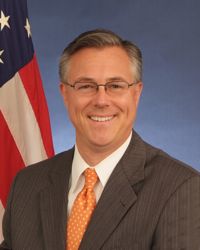
Federal Railroad Administrator Joe Szabo. His family has been in the train business for 5 generations. (Photo courtesy of DOT)
CURWOOD: Now high-speed rail seems like a no-brainer - faster travel, less pollution, job creation - but the process to build these bullet trains in the U.S. has been on anything but a fast track. The Obama administration has ten and a half billion dollars to invest in modernizing the rails, and yet some states are saying - no thanks. Joe Szabo is the Federal Railroad Administrator – and a man with a deep heritage in the industry.
SZABO: I’m a fifth generation railroader. We go back to the late 1800’s with my great, great grandfather who worked for the Chicago Burlington and Qunicy. My father was a forty-year railroader, so I followed his footsteps into the industry.
CURWOOD: Now, along with the U.K., I think the United States is the oldest train country in the world, but we are certainly far from the most advanced. What’s the outlook now for high-speed rail in the U.S.?
SZABO: This is the first president in the United States to really have a vision for rail since Abraham Lincoln and his vision to construct the trans-continental railroad 150 years ago. And, so, since President Obama has made this a priority, and we have been able to, from scratch, put a program together. Less than a year ago we made the first announcements on the first elections for awards, and two years later we’re actually seeing construction start.
CURWOOD: After President Obama announced his rail plan, a number of states really said, ‘eh, we’re not terribly interested.’ I think Ohio, Wisconsin have really dropped out of this process. And, your administration now has shifted this money to California and Florida, which are more shovel-ready. Why are these states opting out of federal largesse for rail?
SZABO: If a state chooses not to move forward with passenger rail at this time, certainly that’s their right. The competition for the dollars is very, very immense, and so it’s very easy for us to shift those resources to those states that are serious about moving forward that understand the importance of providing options. We believe that this program is not only an important part of improving mobility, but has great potential to be a job developer. Studies indicate that 20,000 manufacturing and construction jobs are created for each one billion dollar of rail investment.

President Obama announced plans for new and improved passenger rail in the fall of 2009. The 24 states that applied for high-speed rail corridors is now down to 2. (Photo courtesy of DOT)
CURWOOD: Now, in California, the notion of a high-speed rail between Los Angeles and San Francisco, well, perhaps it’s the most anticipated of high-speed rails here in this country. But, in California, well, there’s a budget problem for the state, even with the federal government helping out - can California afford to pay the bill here?
SZABO: Yeah, there’s no question that California, probably even more than any other state, is well positioned to achieve their vision. You know, the voters there have passed a bond issue that has set aside matching funds for the federal dollars and so their markets, their population density, the distances between San Francisco and L.A., just have tremendous potential.
CURWOOD: Now, the big vision for these lines is to hookup and have a national high-speed rail system. I guess that would be pretty big government, and a pretty big tab – what, a trillion dollars, I think, to do something like that. How justifiable would it be to have a national high-speed rail system?

Federal Railroad Administrator Joe Szabo. His family has been in the train business for 5 generations. (Photo courtesy of DOT)
SZABO: Well, actually, I need to debunk that myth. The vision is not to, you know, have high-speed rail lines that run from New York to Los Angeles. In those cases, air is clearly a more efficient mode. And so, this is more a matter of understanding those regions where inter-city passenger rail actually ends up being a more efficient mode than short-haul regional flights or trying to drive your automobile. So, it’s a matter of allowing each mode to do what it’s most efficient at doing, and in many markets, rail is in fact, the most efficient mode.
CURWOOD: Your dream for the next golden spike to be driven?
SZABO: Well, I don’t know that there’s a single golden spike I’d like to see a series of golden spikes as these projects come to fruition in California and Florida, in the Midwest in the state of Illinois, the improvements that are being made to the Down Easter up in Maine, it’s a great little project up there- the service in Vermont, and seeing the next generation of upgrades to the northwest corridor. So, I’m looking forward to seeing progress made in several different regions across the country.
CURWOOD: Joe Szabo is the Federal Railroad Administrator. Thank you so much, sir!
SZABO: Thank you, a pleasure talking with you!
Related links:
- A map of the Department of Transportation’s vision for high-speed rail
- The Federal Railroad Administration
[MUSIC: Gabor Szabo “Ferris Wheel” from Dreams (Skye Music 1969).]
Prince Charles's Harmony

The Prince started a campaign using a computer animated frog to encourage support for his Rainforest Project. (Clarence House)
PRINCE CHARLES: This is a call to revolution. The Earth is under threat. It cannot cope with all that we demand of it. It is it’s losing balance and we humans are causing this to happen.
CURWOOD: That’s His Royal Highness Charles, the Prince of Wales reading the opening words of his new book, “Harmony: A New Way of Looking at the World.”
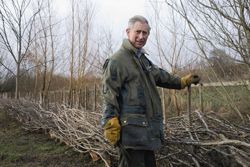
At his home in Gloucestershire the Prince is laying hedgerows using traditional techniques. The hedges are long lasting, provide wildlife habitat, and mitigate erosion. (Charles Sainsbury-Plaice/Clarence House)
PRINCE CHARLES: Revolution is a strong word and I use it deliberately. The many environmental and social problems that now loom large on our horizon cannot be solved by carrying on with the very approach that has caused them. If we want to hand on to our children and grandchildren a much more durable way of operating in the world, then we have to embark on what I can only describe as a “sustainability revolution”--and with some urgency. This will involve our taking all sorts of dramatic steps to change the way we consider the world and act in it, but I believe we have the capacity to take these steps. All we have to see is that the solutions are close at hand.
CURWOOD: Prince Charles is no newcomer on the environmental scene. In a keynote address, at the 2009 climate talks in Copenhagen he urged the world’s leaders to act quickly. For three decades he’s been traveling the world and meeting with experts on everything from deforestation, climate change, to organic farming. And that whole time, he’s been formulating his diagnosis of the problem, and what to do about it. He believes we have lost touch with the basic principles of nature, and prescribes a return to “the active but balanced state of harmony,”--the title of his book.
At the cornerstone of the Prince’s philosophy is what he calls “a crisis of perception.” He believes we are trying to fix the symptoms instead of addressing the true problem - that we have abandoned spirituality and other ways to harmonize with the natural world, in favor of a mechanistic approach.
PRINCE CHARLES: We have come to function with a one-sided, materialistic approach that is defined not by its inclusiveness, but by its dismissal of those things that cannot be measured in material terms.
STEVE: Tony Juniper is His Royal Highness’ co-author, and former head of the Friends of the Earth in the UK.
JUNIPER: We began writing Harmony a little over 2 years ago with a third co-author called Ian Skelly and the 3 of us have been working to really encapsulate and to project the underlying philosophy that has been Prince Charles’ driving mission.

The Prince started a campaign using a computer animated frog to encourage support for his Rainforest Project. (Clarence House)
CURWOOD: Isn’t Prince Charles’ view quite radical here, in calling for revolution. Part of the thesis here some might see as a call really to the end of capitalism. I mean, in the book one finds the thesis that economic growth is not a good thing.
JUNIPER: We don’t call for the end of capitalism, but what we do say is that the existing capitalist system is in grave danger of self-destruction if it leads to the removal of the fundamental services which underpin it. All of that economic development which we measure in terms of growth and GDP, ultimately is dependent on nature and the argument we make is that without the natural capital, all of those different ecosystem services, capitalism in terms of the economic phenomenon which we measure and grow and which many of us derive our wealth from, it cannot continue.

The native red squirrel has disappeared from much of its native range in Britain. (Charles Sainsbury-Plaice/Clarence House)
CURWOOD: What does it mean to be the Prince of Wales, to be in this position? And how does he see himself and deal with what others think of him as he presents these ideas?
JUNIPER: I think the heir to the British throne, to be the Prince of Wales, is for him the opportunity to take a long-term view on behalf of the whole of society. But he doesn’t need to be re-elected every 5 years, he doesn’t need to improve the quarterly results of a corporation, he doesn’t have to be driven by the 24 hour, 24/7 news headlines, he’s able to take this long-term view. And I think for him, that’s the core of what it means to be the Prince of Wales. You know, the British royal family, the British monarchy, the institution of the British monarchy, if it can do anything that’s going to be of great assistance in our modern world, it’s doing that. To be able to look over the horizon in a way which so many other institutions cannot do, for reasons that we all understand.
CURWOOD: Tony Juniper is co-author with Ian Skelly and Charles the Prince of Wales of the book “Harmony: A New Way of Looking at Our World.” Thank you so much, Tony.
JUNIPER: Thank you so much Steve, it’s a great pleasure to be able to contribute.
Related links:
- Check out the documentary inspired by the book Harmony
- Tony Juniper’s website
[MUSIC: Andrew Bird “Scythian Empires” from Armchairs Apocrypha (Wegawam Music 2007).]
Judy Bonds Remembered

Judy Bonds.
CURWOOD: In the coal country of West Virginia, a courageous voice has fallen silent. Coalminer’s daughter-turned activist Judy Bonds died January 3rd after a battle with cancer. She was 58 years old. Ms. Bonds won the Goldman Environmental Prize in 2003 for her fierce and uncompromising opposition to coal industry abuses.
[BONDS ADDRESSING CROWD AT A RALLY]
BONDS: Over 100 years ago, the greed and corruption of the coal industries stole our great state. We’re here to take it back today, starting with Coal River Mountain!
[CHEERING]
CURWOOD: The Coal River Valley in West Virginia is ground zero in the fight between environmental activists and coal companies that blast the tops from mountains to expose coal seams. The waste rock and dirt are dumped into streams and valleys, including Marfork Hollow, where Ms. Bonds and six generations of her family had lived. Mountaintop removal forced her to leave her home.

Judy Bonds.
BONDS: Every time I pass by this hollow, I look, and it hurts. It breaks my heart, because this is where I was born and raised, it hurts.
CURWOOD: When Living on Earth’s Jeff Young profiled Judy Bonds in 2003 she said the memory of the land that had sustained generations of her family motivated her to act.
BONDS: The celebration of life was everyday, the connection everyday to the community and to the land, and to the rivers and the streams. And that's basically what we're trying to preserve.
CURWOOD: Ms. Bonds and her grassroots group, Coal River Mountain Watch, waged a campaign against Massey Energy, operator of many mountaintop removal mines. Massey Energy has a poor safety record, including an April 2010 explosion that killed 29 men. Ms. Bonds looked for any way to slow the mining down, including scanning maps for old family cemeteries near a mine’s boundary.
BONDS: There's a law in West Virginia, and they cannot mine within 300 feet of a cemetery. Basically, I would say our dead ancestors are helping us to fight these coal companies.
CURWOOD: Judy Bonds herself will be buried in a family cemetery along the Coal River, at rest among the mountains and streams she cherished.
Related links:
- A memorial website in memory of Judy Bonds
- LOE’s April 2003 profile of Judy Bonds, Goldman Prize winner
[MUSIC: Bill Frisell “Wildwood Flower” from Ghost Town (Nonesuch Records 2000).]
CURWOOD: Just ahead –how today’s ubiquitous chemicals may be affecting our children – and sexual preference. Stay tuned to Living on Earth.
ANNOUNCER: Support for the environmental health desk at Living On Earth comes from the Cedar Tree Foundation. Support also comes from the Richard and Rhoda Goldman Fund for coverage of population and the environment. And from Gilman Ordway for coverage of conservation and environmental change. This is Living on Earth on PRI, Public Radio International.
[CUTAWAY MUSIC: Billy Taylor: Two Shades Of Blue” from Homage (GRP Records 1995).]
Hormone Disruptors Linked To Genital Changes and Sexual Preference
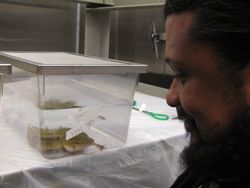
Tyrone Hayes' at work in his lab in Berkeley (Photo: Ashley Ahearn)
CURWOOD: It’s Living on Earth, I’m Steve Curwood. From the carpets in our living rooms to the liners of our canned goods we’re exposed to manmade chemicals every day. We use synthetic chemicals for everything from plastics to pesticides. They eventually make their way from our farms, households or industry into the environment – and into our bodies. And they may be affecting our reproductive health – indeed, even our sexual preferences. Producer Ashley Ahearn reports.
[DOOR OF FROG LAB ROOM OPENS, VENTILATOR FAN RUNNING]
HAYES: So these are the South African Claw frog.
[WATER SLOSHING IN TANK]
AHEARN: Tyrone Hayes peers into a large gray fiberglass tank like a little boy looking for critters in a tide pool. Below the surface, fat greenish-yellow frogs swim around– their bulging eyes looking up at us through the water.
HAYES: So in this tank there are 40 brothers that are not exposed to atrazine and in this tank there are 40 brothers who were exposed to atrazine and so we can compare these two tubs and look at the number of homosexual pairs. This for example is one that has lots of gay males, homosexual pairs in it because it’s a treated tank.
AHEARN: One morning when one of Hayes’ PhD students came in to feed the specimens at 7 AM she noticed some male-on-male copulation going on in a tank that had been treated with atrazine – the second most commonly used herbicide in the U.S. Once Hayes heard about this he started collecting data. He exposed some of his frogs to the same level of atrazine that the Environmental Protection Agency says is safe for drinking water, and he kept the rest of the frogs atrazine-free.
HAYES: So what you can see is that there’s a seven-fold difference in the atrazine treated animals.
AHEARN: Homosexual behavior has been recorded in over 450 different species of animals – from bison to beetles. But Hayes’ research showed that atrazine exposure made these frogs 7 times more prone to homosexual behavior and10 percent of the exposed frogs actually became feminized.
[FOOTSTEPS TO LAB]
AHERN: To explain what he meant by “feminized” Hayes brought me back to his office and pulled up a picture on his laptop of a frog that had been exposed to the herbicide.
HAYES: This is an animal that looked like a female on the outside. But on the inside it had large testis, so these are testis, and this is an oviduct. So, this is the equivalent of a man with a uterus.
AHEARN: These frogs aren’t just behaving like females – they’re actually producing eggs and when those eggs are fertilized by normal male frogs, the babies grow up to be seemingly normal frogs. Let me say that again: the male frogs are having babies. And there are consequences. HAYES: …because they don’t have a female chromosome the females that are genetically males can only produce other males so 100 percent of their offspring would be males.
AHEARN: And more male frogs means fewer babies down the road. Hayes says this might be one reason that populations of frogs and other amphibians all over the world are going down. HAYES: In our work with frogs for example we can go into the field. We’ve done this, others have done this. There’s another study that just came out in Canada showing that if you go to an environment that’s contaminated with atrazine you find more hermaphroditic or abnormally developed males.
AHEARN: The reproductive problems Hayes is seeing in his specimens aren’t limited to frogs. Studies on rats, reptiles and even human cells exposed to atrazine showed similar results. Recently, scientists with the U.S. Geological Survey found intersex fish in one third of the waterways they tested across the United States.
And atrazine is not the only chemical to blame for causing widespread reproductive health problems. It’s a member of a family of chemicals known as endocrine disruptors.
COLBORN: Well basically they’re chemicals that have been around for quite a while, we just didn’t know what they were doing.
AHEARN: Dr. Theo Colborn was one of the first to sound the alarm on endocrine disruptors and how they affect reproductive health and development when she co-authored the book “Our Stolen Future” in the late 90’s. At first, people saw her as a bit of a radical, but over a decade later the government is channeling more and more funding towards researching these chemicals and there’s a new act in Congress that will require better testing of suspected endocrine disruptors.
Colborn says it’s about time. We’re constantly exposed to them.
COLBORN: They’re in plastics. They’re in our toys, the children’s toys. If you go to your kitchen sink and under your bathroom sink and look at the cleaning compounds that are there. The cosmetics. The toiletries. They’re just about in everything because they’ve made every one of these products much nicer. They last longer. They’re preservatives. They’re fire retardants.
AHEARN: The endocrine system is made up of a series of glands throughout the body that control the hormonal messages that direct development. By imitating natural hormones– such as estrogen and androgen – endocrine disrupting chemicals prevent the body from sending and receiving those messages. Dr. Stephen Rosenthal, a pediatric endocrinologist at the University of California San Francisco, broke down some basic human developmental biology for me. He says in the womb, we all start out developing as girls.
ROSENTHAL: If you consider the gonads, which basically is the other name for the testis or the ovaries, in any baby - either boy or a girl – that, basically, these gonads are pre-programmed to become ovaries unless there’s an overriding signal that tells them to become testis.
AHEARN: If you’re a boy that over-riding signal comes from a gene on your Y-chromosome. It tells your gonads to become testis, instead of ovaries, and to start producing testosterone and androgen. Those hormones then travel through the body and hook up with receptors in cells.
ROSENTHAL: That sets off a chain of events inside a cell. It’s like if you need a key and an ignition to start a car right, so the key goes into the ignition and then the whole thing can turn and the car goes on.
AHEARN: The car “going on” would equate to normal development of a fetus. Now picture some chewing gum in the ignition. The key won’t fit. The car won’t start – or, as Rosenthal explains - normal masculine development won’t proceed.
ROSENTHAL: If there is some agent, some environmental disruptor that interferes with the normal functioning of the Androgen Receptor then it’s very likely that in a male there will be incomplete masculinization of the external genitalia.
[SOUND OF FROG TANK ROOM]
AHEARN: The atrazine-exposed male frogs in Tyrone Hayes’ lab look just like females, which are much larger than the typical male African Claw Frog and have smaller breeding glands and differently formed feet and gonads. Tyrone Hayes says just because frogs aren’t people that doesn’t mean we should ignore the warnings.
HAYES: People go, well, it’s frogs. I go, yeah but look, the estrogen that works in this frog is exactly, chemically exactly, the same as the estrogen that regulates female reproduction. Exactly the same testosterone that’s in these frogs regulating their larynx or their voice box or their breeding glands or their sperm count is exactly the same hormone in rats and in us.
AHEARN: So, what about us? Could endocrine disruptors be having feminizing effects in humans? No one knows for sure, but some believe that rising rates of one birth defect could be an indicator.
[CAFETERIA SOUNDS AT OAKLAND CHILDREN’S HOSPITAL]
AHEARN: Dr. Laurence Baskin is a pediatric urologist with the University of California, San Francisco but he practices here at the Oakland Children’s Hospital part time. Today he’s performing back-to-back surgeries - and a very specific type of surgery. Baskin specializes in correcting hypospadias – the second most common birth defect in the country behind heart disease.
BASKIN: About one in 125 to one in 250 newborn males has an abnormality in their genitalia that could be described as hypospadias – and what I mean by that is penile curvature, abnormal urethra and an abnormal foreskin and putting that together that’s what hypospadias is defined as.
AHEARN: More babies are born with hypospadias than Down’s syndrome or cleft palate, and some research suggests that rates of hypospadias have increased in the past few decades. Baskin and others in his field suspect environmental exposures may contribute to hypospadias. Think back to the gummed up lock and key that Stephen Rosenthal described. All fetuses are programmed to develop ovaries unless they’re told otherwise by certain hormones like testosterone and androgen.
Endocrine disrupting chemicals, like atrazine for example, could gum up the receptors for those hormonal messengers that tell a fetus to develop into a baby boy– or as Baskin explains – prevent the fetus from fully masculinizing.
BASKIN: The penis wouldn’t develop. It would be arrested - meaning that your urethral opening would be lower down in the penile shaft, the penis normally as it develops is curved and it straightens out so in Hypospadias it wouldn’t have straightened out and the foreskin would only have formed on the top of the penis, wouldn’t be able to come down to the bottom because that lock or that hormone receptor would be blocked or disrupted by the environmental toxin.
AHEARN: Ok, so if Tyrone Hayes is finding feminizing effects in frogs who are exposed to atrazine – one of these environmental toxins that Baskin is talking about – are there some parallels to be drawn in human beings? Baskin pauses for just a split second before responding.
BASKIN: Humans clearly are not frogs, but the theory is correct. And in this case we would agree with Dr. Hayes that an environmental disruptor, something in the environment, chemical toxin or medication could certainly be a risk factor for Hypospadias.
AHEARN: Baskin says the majority of hypospadias can be fixed with a relatively quick surgery that can make life a lot easier for the child later on.
BASKIN: I think growing up as a teenager and not having normal genitalia would be tough enough, even if you have normal genitalia, just for regular emotional and sexual development so that’s really the major reason to fix it, so kids can be normal.
[ELEVATOR DOOR, HALLWAY, PHONE RINGS]
AHEARN: But “normal” is a loaded term for some. Dr. Tiger Howard Devore is a sex therapist and clinical psychologist in New York City.
DEVORE: Isn’t it great that some doctor can tell you what’s normal? I love that.
AHEARN: For Devore, this is a personal story.
DEVORE: One of my earliest memories is of being in a hospital and dealing with some physician taking bandages off of my genitals and watching my parents respond in obvious fear about whatever it was that this guy was doing. I was probably maybe three. But I had my first surgery when I was three months old and I had at least one surgery every year after that until I was at least 12.
AHEARN: Devore was born with severe hypospadias. All told, he’s had 20 operations on his penis. It wasn’t until college that Devore came to terms with his condition and decided to devote himself to helping others born with Hypospadias. As a psychologist, he says that if you follow Rosenthal and Baskin’s logic and look at hypospadias as incomplete masculinization of the genitals…
DEVORE: … the same thing probably happened in the brain in the areas where there’s sexual differentiation of the brain. Now it doesn’t make a person gay, lesbian, bisexual or transsexual but it certainly makes it easier for that person to be any of those things.
AHEARN: There is no peer-reviewed scientific research to back up Devore’s claim about sexual orientation and hypospadias. However, the Hypospadias and Epispadias Association – a group which works to raise awareness about these two similar genital conditions - conducted an online survey of roughly 700 men – both with hypospadias and without. The survey found that men with hypospadias were 15 percent more likely to describe themselves as gay.
I told Devore about Tyrone Hayes – the biologist at Berkeley with the homosexual and feminized frogs – and I asked him what he thought about those findings in relation to people. He said the connection makes sense…
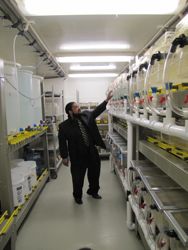
Tyrone Hayes' at work in his lab in Berkeley (Photo: Ashley Ahearn)
DEVORE: …but we can’t prove it because we can’t experiment on human beings. We can certainly look at populational [sic] models and say this looks like it’s pretty closely related, we probably should take some actions here to see if it is, but we can’t say that we know the whole story yet.
AHEARN: Devore says there's a whole lot more to someone's sexual orientation than the chemicals they may have been exposed to during development.
DEVORE: This isn’t just about where you stick your things. This isn’t just about how you get good sensation in your body. This is about who you fall in love with. This is about a whole complex set of social factors.
[BOOTS ON WOODEN PORCH]
AHEARN: It’s a cool rainy day in Massachusetts when I pull into Alice's dirt driveway and walk up the steps to her log cabin style home.
[KNOCKING ON DOOR]
ALICE: Hey! You found us out here in the woods.
SON: When you come here, where are the chocolate chips?
ALICE: Are you going to melt them? Ok.
[MICROWAVE DOOR OPENS AND SHUTS, BUTTONS BEEP AND MICROWAVE STARTS UP]
AHEARN: At seven years old, Alice's son’s red head is just above counter level.
[FINISHES BEEPS, DOOR OPENS AND SHUTS AGAIN]
SON: Aaaah. Done!
AHEARN: He gets a spoon to mush the melted chocolate chips around, and comes back out to sit with his mom and me at the kitchen table.
ALICE: I mean, I talk to him about it personally. He knows he has hypospadias and he knows he’s met other people that have it.
AHEARN: Since her son was born, Alice has worked to raise awareness about hypospadias. She also counsels mothers of kids with hypospadias. But she says more attention needs to be paid to figuring out what causes this condition, and communicating that information with the public.
ALICE: What concerns me the most is that the information is there, that these environmental estrogens are having effects… it’s common sense, I mean, if this is what’s happening, why isn’t the information getting out there? I guess my big question that I have is why can’t people talk about it? Why can’t we talk about it as a society?
AHEARN: Talking about problems with reproductive health is something society has never handled well. And perhaps because most hypospadias can be corrected with surgery, very few doctors have raised questions about the underlying causes of this birth defect.
But endocrine disrupting chemicals show up in almost 100 percent of the population, according to the Centers for Disease Control, and many of these chemicals are known to disrupt normal reproductive system development in animals - think back to Tyrone Hayes' frogs here.
So I asked Dr. Theo Colborn, who's been studying endocrine disruptors for over 30 years, if she thought our environmental exposures could be affecting our reproductive health. Or more specifically, given what we’re seeing with hypospadias, I asked her, do you think we are feminizing our baby boys?
COLBORN: I definitely do. I think there’s a certain percentage that are definitely being affected and there’s no denying it.
AHEARN: It's one thing to say that exposure to endocrine disrupting chemicals may contribute to hypospadias. It's quite another to say that a person's sexual orientation could be shaped, in part, by their environmental exposures. That, Colborn says, is an explosive issue. No one wants to touch that research.
COLBORN: If you were to ask for dollars for that you wouldn’t get the money. I mean, you would be laughed out of your chair, believe me. It’s that sensitive.
AHEARN: Sensitive, and therefore still very early in terms of scientific findings and evidence. But important questions are now being raised. What effects might chemicals in our environment – particularly those to which we are exposed before birth – have on our reproductive health and the expression of sexual identity? For Living on Earth, I’m Ashley Ahearn.
Related links:
- A study that looks at hypospadias and endocrine disruptors.
- Hypospadias and Epispadias Association
- Dr. Tiger Howard Devore
- Tyrone Hayes' research: Hermaphroditic, demasculinized frogs after exposure to the herbicide atrazine at low ecologically relevant doses
- Tyrone Hayes' research: Herbicides: Feminization of male frogs in the wild
CURWOOD: Thanks for support from the Annenberg School for Communication and Journalism at the University of Southern California. If you have thoughts – we’d love to hear them -- at comments at L-O-E dot org. – that’s comments @ loe.org - or on our listener line – 1-800-218–9988 – or via our facebook page – it’s P-R-I’s Living on Earth.
BirdNote® - New Year Dawns

New Year Dawns. (Photo: Mike Hamilton ©)
[BIRDNOTE THEME]
CURWOOD: Here to help kick off a New Year is Mary McCann with BirdNote.

The sun is up and so are the snow geese. (Photo: Mike Hamilton ©)
[CICADAS CHIRPING]
MCCANN: Listen! The Earth awakens as dawn circles the globe.
[BIRD NOISES, A SYMPHONY OF DIFFERENT SPECIES]
MCCANN: Sounds for today’s BirdNote were recorded around the globe by Gordon Hempton, Soundtracker.com, I’m Mary McCann.
[MUSIC: Leo Kottke “Bigger Situation” from One Guitar, No Vocals (BMG Entertainment 1999).]
CURWOOD: Living on Earth is produced by the World Media Foundation. Our crew includes Bobby Bascomb, Eileen Bolinsky, Ingrid Lobet, Bruce Gellerman, Helen Palmer, Jessica Ilyse Smith, Ike Sriskandarajah, Mitra Taj, and Jeff Young, with help from Sarah Calkins, and Sammy Sousa. We bid a grateful farewell this week to Emily Guerin, and to our interns, Nora Doyle-Burr and Honah Liles. We wish you all the best of luck. Jeff Turton is our technical director. Alison Lirish Dean composed our themes. You can find us anytime at LOE dot org – and while you’re online, check out our sister program, Planet Harmony. Planet Harmony welcomes all and pays special attention to stories affecting communities of color. Log on and join the discussion at my planet harmony dot com.
And don’t forget to check out the LOE facebook page, it’s PRI’s Living on Earth. I’m Steve Curwood. Thanks for listening!
ANNOUNCER: Funding for Living On Earth comes from the National Science Foundation, supporting coverage of emerging science. And Stonyfield Farm. Organic yogurt and smoothies. Stonyfield pays farmers not to use artificial growth hormones on their cows. Details at stonyfield.com. Support also comes from you, our listeners. The Ford Foundation, The Town Creek Foundation, The Oak Foundation- supporting coverage of climate change and marine issues. And Pax World Mutual Funds, integrating environmental, social, and governance factors into investment analysis and decision making. On the web at paxworld.com. Pax World For tomorrow.
ANNOUNCER 2: PRI Public Radio International.
Living on Earth wants to hear from you!
Living on Earth
62 Calef Highway, Suite 212
Lee, NH 03861
Telephone: 617-287-4121
E-mail: comments@loe.org
Newsletter [Click here]
Donate to Living on Earth!
Living on Earth is an independent media program and relies entirely on contributions from listeners and institutions supporting public service. Please donate now to preserve an independent environmental voice.
NewsletterLiving on Earth offers a weekly delivery of the show's rundown to your mailbox. Sign up for our newsletter today!
 Sailors For The Sea: Be the change you want to sea.
Sailors For The Sea: Be the change you want to sea.
 The Grantham Foundation for the Protection of the Environment: Committed to protecting and improving the health of the global environment.
The Grantham Foundation for the Protection of the Environment: Committed to protecting and improving the health of the global environment.
 Contribute to Living on Earth and receive, as our gift to you, an archival print of one of Mark Seth Lender's extraordinary wildlife photographs. Follow the link to see Mark's current collection of photographs.
Contribute to Living on Earth and receive, as our gift to you, an archival print of one of Mark Seth Lender's extraordinary wildlife photographs. Follow the link to see Mark's current collection of photographs.
 Buy a signed copy of Mark Seth Lender's book Smeagull the Seagull & support Living on Earth
Buy a signed copy of Mark Seth Lender's book Smeagull the Seagull & support Living on Earth

